[This post is part of the Digital Rights Blog Series.]
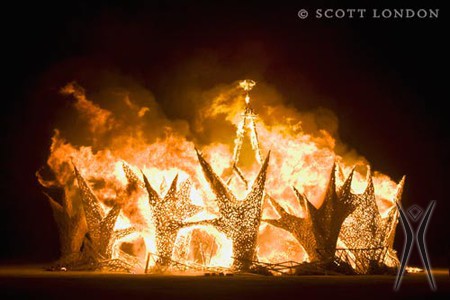
Six weeks hence will again see me covered in dust, in the middle of a desert wasteland and my largest project of the year, that thing we call Burning Man. It will be the sixth year I bring out a glittering array of sparkling glass and battered camera bodies, trying to somehow make the unimaginable scale of the event fit within a small viewfinder, compressing the four dimensions of time and space (leaving out sound entirely) into a measly two, and somehow still try to convey just what it is like — near sensory overload — within a few photographs.
In 2008, I posted a few photos during the week from the tenuous WIFI connection to my website; last year, I took this up a notch and posted photos each night of the event from their respective day. With a generator running, a laptop atop the pickup and photos of the Man burning trickling up to the web at 3AM — scant hours after his immolation, and while his embers smoldered still — I hastily packed my remaining belongings to escape the mad rush of Exodus, and my photos beat me to the rest of world.
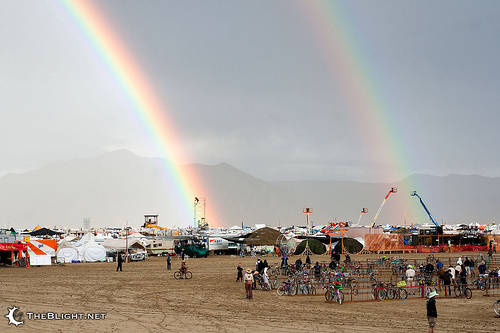
The reaction was huge, and the outpouring of thank-yous and appreciation overwhelming. They came from Burners and non-Burners alike: those who were unable to make it out to the desert due to financial, health, work, or familial situations; or those who had friends, family or significant others on the playa but had to themselves stay home. My nightly image postings allowed them to live vicariously and catch a glimpse into a world that they could not be in at that time. They drank them up.
I realized then that this was my art project. In years previous, I’d tried to work on other projects or infrastructure, and took for granted the picture-taking aspect of my trip; it was after these folk came forward to say how much being able to see images while the event unfolded meant to them that I realized this is why I go out there, to try to give a real-time “this is how it is” view of the Burn. Taking photographs is not just something that I do, it is what I do. My enjoyment of an event is intrinsically an inextricably linked to my taking photographs of it, and when I can’t, my enjoyment is substantially lessened.
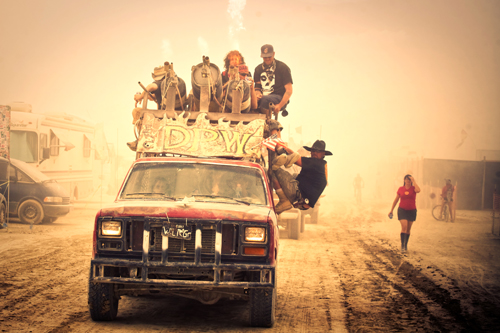
Amongst 50,000 Burners, you’ll find 50,000 different ideas of “what is Burning Man,” and what ideals we have there and why we go. Some people are looking for freedom, and the idea of finding themselves on a website later is seriously restrictive to that, while others think that taking photographs interferes with one’s ability to enjoy the event and therefore hold in disdain or contempt us photographers. What they forget is that, for the “good ones” at least, we’re as much members of the community as they are.
We are not silent observers — voyeurs — sneaking through the event and surreptitiously taking photos that magically appear on the internet later; no, we interact with our subjects, striking up conversations and asking permission, getting drunk and partying with the rest of you fine folk because we are you folk, too. You tend bar, served grilled cheese, give out free hugs (creepy or otherwise), yell belligerently on a megaphone, run a radio station, ride a bike and look at art, build the city or clean it up afterward, guard the Temple, work with the medics or serve as a Ranger; I take pictures.
My photographs are my gift to the community. I license my images Creative Commons, freely granting non-commercial use, only asking that they not be modified without permission (my watermark is on them and I don’t want to take credit for someone else’s modifications) and requiring attribution. They end up on blogs, as peoples’ profile pictures, hosted as galleries on other peoples’ Facebook and Flickr accounts, sent to friends and families, used as fliers for parties or even integrated into other art projects, and it thrills me to see them enjoyed so widely.
I am, however, a stickler about the attribution requirement. Why is that? Isn’t a gift supposed to be in the giving, expecting nothing in return? The answer is important, and my reasoning is one built over years of photographs of people.
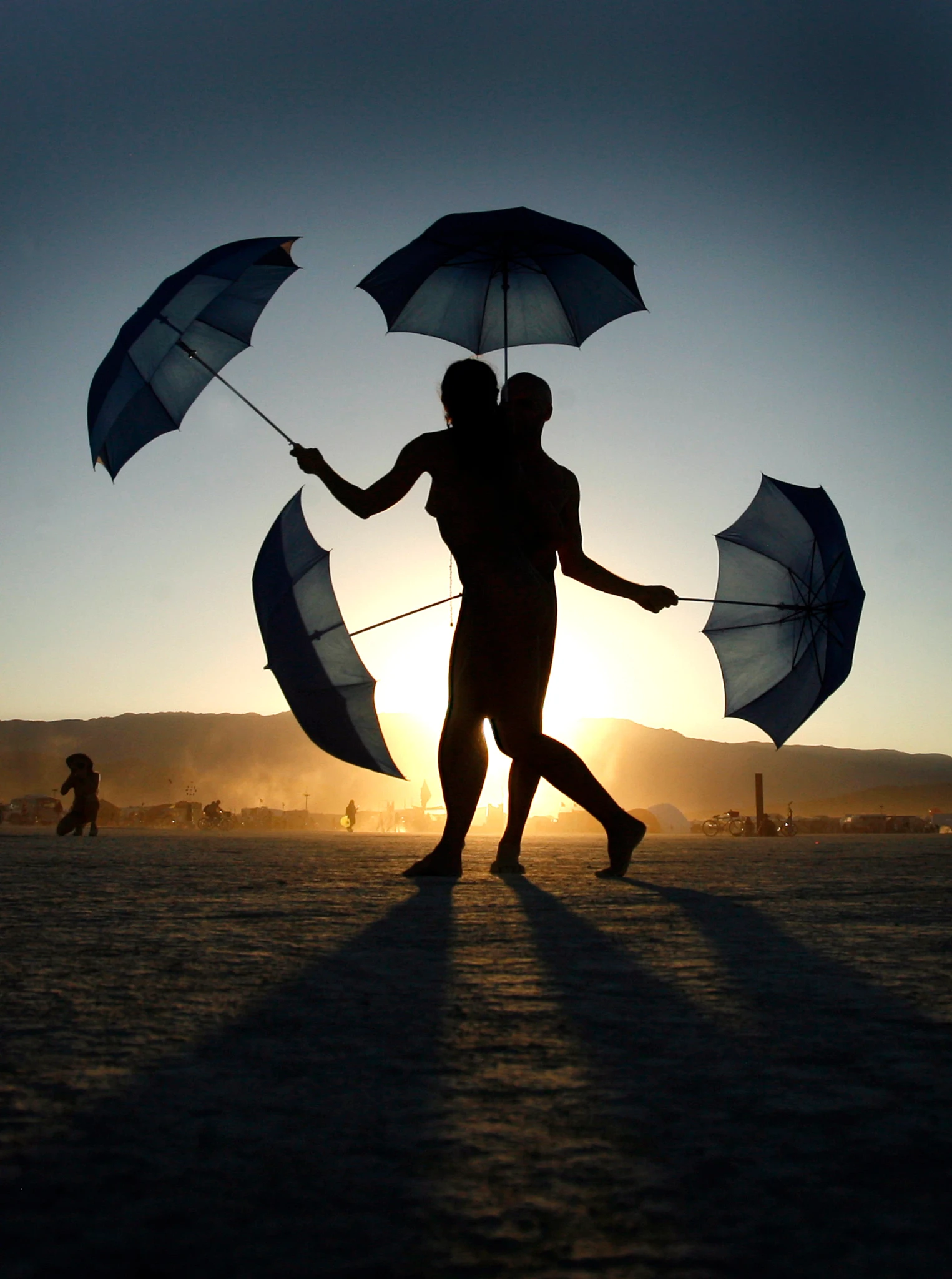
Taking photographs of people is an extremely personal action. I have the ability to make someone look good or bad, to potentially catch and bear witness to an illegal activity or to expose someone to friends and family (or worse, coworkers or constituents) back home where there might be serious professional or personal repercussions. Many people are thusly gun-shy around cameras. It’s a great responsibility to hold the power to potentially damage someone’s career, and I take this very seriously. People are rightfully so very hesitant when someone points a camera at them; as such, my reputation is of the utmost importance when it comes to photographing people.
There are a great many who do not ordinarily let themselves be photographed, but who will allow me to do so, being already familiar with my work and knowing I hold the greatest respect for my subjects and their privacy; this is a great honor, and one I do not take lightly. It is therefore very important that people I hope someday to photograph are familiar with my work ahead of time, and why attribution is then so very important. Failure to attribute a photograph–or any work of art–is a deprivation of social equity, and it directly impacts my ability to effectively shoot in the future.
Another aspect very important to the Burner community is that of decommodification; some take this to mean Burning Man is a commerce-free zone, but others rightfully point out the ice and coffee sales, and others the amount of money spent on preparing for and getting to the event. Photographs are one of the most ubiquitous pieces of media to leave the Burn, and commercial entities seek them: advertisers, gear and clothing retailers, and magazines and other publications seek images in addition to Burners themselves seeking images of a piece of art that defined the event to them or especially one that they helped build.
This presents me with a quandary: when it comes to prints, I can’t afford to simply give them away, for they’re expensive. And if someone else is making money from my images, it’s only fair (and enables me to make more images for you) to share those proceeds. I do not and have never ever supported pure commercial use, such as using a Burning Man image for advertising. That runs contrary to the principles of Burning Man, and I think it a betrayal of the trust the community places in me to use them in such a manner.
But what about a news editorial? Those companies make money from content: should we say that they can’t run a story on Burning Man because of that? No, because that’s ridiculous. But then why should I be obliged to give my work away for free to people profiting from it, either?
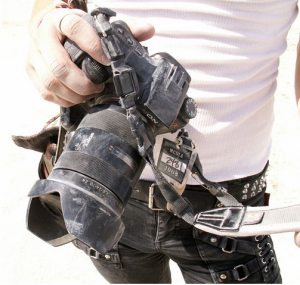
I allow anyone to use my work noncommercially, and am happy to lend my images to artists for fundraisers and the like at no cost (or, for prints, at cost). But if you’re going to profit from my images, I expect to share the proceeds with you, money that then goes right back to the community as I pay for new gear and cover the large expense of taking and providing images for the community. I’m no DJ or performance troupe, so it’s hard for me to throw a fundraiser for myself (also, how lame would that be? Woo!) so consider that to be a potential source of my budget (so far, know that everything I do out there is 100% out of my own pocket).
The issues surrounding digital rights are extremely complex, and there are no right answers: a right answer for me might impinge upon your rights, and vice-versa. And with a community as vocal and opinionated as Burning Man’s (and we love you for it), there’s no way to make everyone happy anyway. I have attempted to put forth my thoughts and feelings on the matter, and have, in my humble opinion, what I think to be a fair and respectful approach to this most confusing state of affairs, but certainly others will feel differently. I do absolutely appreciate constructive feedback from you, the community (and my potential photographic subjects!) as to ways I can best serve with my images, striking a balance between art/documentation and invasion of privacy/paparazzi, and commercial (editorial) use and decommodification.
If you see me on the playa, don’t hesitate to ask me to take your photo! Willing subjects make the best subjects. Or if you can’t make it this year, check my website or Flickr each night around 7am (yes, you heard me right) for my daily photo posts (announcements are made on my Twitter stream. Choose your poison.
[Chayna Girling is a photographer and blogger covering the San Francisco Bay Area underground. Larger than a breadbox and something of a chameleon, you may find them after dark at unusual haunts betwixt and between the unusual, making you ask yourself “Why wasn’t I there?” You can see their work on TheBlight.net.]

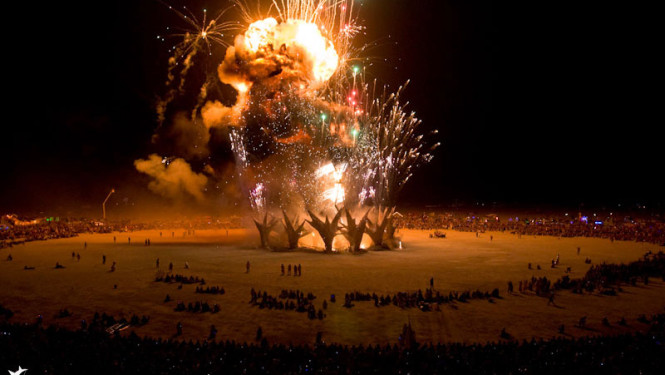
It was nice to read how you feel about making images at Burning Man, I among many am familiar with your work.
Though, and this might not be your responsibility, speaking of photography through the guise of Digital Rights adds a bit of murkiness to the waters.
This isn’t a digital rights, facebook photo gallery debate. Or, at least.. It shouldn’t be.
Photography has been an important part of the culture of the world for over 100 years.. The breakthroughs of digital image making and the internet have done nothing to change this. Despite how people feel camera phones change things photography has remained the same thing as it always was.
Photography itself is innocent. The same motivations for making images and being an astute image maker today are the same as when photographing people in the past. The same complaints, the same worries, the same implications exist.
The trouble is that we seem to collectively relive the same debate over and over with each new innovation.
From people seeing an ancient daguerreotype of a willing as an offense, to the innovation of the flash photography that allowed newsmen like Weegee to capture some of the most important images in the medium to papparazi and facebook. It is all the same thing.
Again, photography is inherently innocent. To limit photography due a few folks offending the sensibilities of others is just as offensive today as it was 100 years ago.
It is good to see that people like you, Neil do a great service to demonstrate that photography can be, and is, a viable creative artistic medium. One that I feel should not be limited by the ever changing sensibilities of the time.
If we were to put a limit on photography today, think about what could be lost in the future.
Report comment
I think you are right to mention the tension between photographer and (potential) subjects.
When there is a camera located in between the line of sight of the photographer and the view of a subject, both people have an interest in deciding if that camera is used or not. Both have a right in the matter. The tension develops into a struggle when one person in that arrangement wants to use the camera and the other does not.
(And yes, I have been in the not-that-rare instance in which someone demanded I take their photo and I did not want to. Happily I control the future use of that photo, so I just snap and toss it out later.)
In the situation in which the subject does NOT want their photo taken, their rights are directly opposed to the photographer. After all, s/he physically controls the device, s/he spent thousands of dollars on the gear, s/he can still choose discretion later and not share the photo, just keeping it to look at for themselves. Yet without the subject doing something noteworthy (even if that is the mere act of being present and interesting looking) there is no photo. The subject has a little bit of power too, whether that is to turn away, cover up or hide behind nearby objects.
It’s when the power of either individual is used without consent, without even notifying the other individual, that someone is trumping their rights over another. If I someone sees my camera (let’s say a performer) and they immediately run away, not only do I lose the shot, the performance has ended too; probably to my disappointment. When they could have just ask/told me not to use the camera.
More often, though, it is the photographer that does not engage in the agreement required to negotiate the use of rights.
But it is so easy to risk a little rejection and strike up the conversation required to earn trust and be allowed to share in the process with your subject. True, this occasionally requires that you work backward, taking shots at the moment the amazing thing is happening and then approaching your subject for permission. But that situation does not come up as often as you might think. And when you are aware that the opportunity to ask will never come (e.g. they are riding into the sunset with their bare breasts), it should be a moment in which you examine your morality before you click the camera.
Again, thanks for bringing up the nature of the tension in rights between the subject and the photographer.
Report comment
Neil- you’re part of the solution, not part of the problem. Your photos are amazing and your respect for the participants is wonderful. Thank you for your contributions!
The issue is more with the people who DON’T ask first, who DO just collect photos of naked/topless women, who don’t have that respect. Who don’t interact. It’s a whole different feeling (and that’s the kind of thing that keeps my top ON at Burning Man, and not appearing in any garment that I wouldn’t be comfortable seeing splashed across the internet).
I don’t know what the answer to that might be, but I know it’s up to me to police my OWN behavior because the threat of these many many pervy men with cameras is a very real threat and is very uncomfortable.
Report comment
great writing Neal. i have always enjoyed your BM Flickr sets and applaud you for using the Creative Commons license. too many BM photogs on Flickr anxiously hoard their pictures with the All Rights Reserved option, only allowing low resolution viewing or worse, covering all of their shots with big ugly watermarks. this attitude always reeks of desperately wanting artistic validation and attention when the images should speak for themselves.
Report comment
Camera phones are in great demand these days, i own at least two of them`~”
Report comment
Great writing, Neil !
Report comment
Great post, Neil…I agree with your sentiments and this dialog needs to expand to include audio as well…this year I used a TASCAM recorder to get a soundscape to add another dimension to my images to share with friends for non-commercial uses…same rules apply regarding capture, I was careful to ask before recording and in only one instance was asked not to record…I personally have a problem with the BM claiming ownership to the images (and perhaps audio recordings?) that I take. This is counter to US copyright laws where the photographer owns the image. This makes BM an isolated island…clearly protecting individual privacy is a concern, but people who attend are adult and know they are exposing themselves (both literally and figuratively) when they come to BM…why should BM treat these images any differently than a photographer capturing an image of a streaker at a football game other than its motivation to protect corporate assets…this seems to be at odds with the BM philosophy…let the debate continue…
Report comment
“We are not silent observers — voyeurs — sneaking through the event and surreptitiously taking photos that magically appear on the internet later; no, we interact with our subjects”
I don’t think you are in position to speak on behalf of all photographers at Burning Man. There is no “we”, because while your personal agenda might be participatory, it’s very clear that there are numerous others who seek to exploit Burners and profit from their choice to expose themselves. Personally, I really appreciate the gift photographers give to the community. I haven’t been able to attend the festival for a few years now, and I hang on every shot. But I don’t really see how the current restrictions hamper photogs all that much. You can after all, shoot pretty much whatever you want, post those photos in public forums, and even sell the shots with permission (with those proceeds going back into the event itself).
I will admit to being uncomfortable with the restrictions, and I even think they are a bit hypocritical, but lets face it, if this were opened up, and suddenly there was a billion gorgeous tits plastered all over the internet, you can kiss the festival as you know it goodbye. You wouldn’t be able to ride your bike without running into some asshole throwing shitty beads at women right left and centre. We can’t pretend this isn’t the case. This is, after all, the United States of America, and candid shots of gorgeous boobs is a commodity.
So given a choice between photographers being able to sell shots to the media freely (even with the best of intentions) which would also open it up to those with the worst of intentions vs telling you that you have to go through a process… then I’m okay with the restrictions, and will gladly live with the label of hypocrite.
Report comment
I should add that I’m Canadian, and we come at things differently than Americans. You guys are all “Life Liberty and the Pursuit of Happiness”, whereas we’re all “Peace, Order and Good Government.” Arguable that means we’re not as “free”, but hey, it works pretty well, and we have plenty of “preverted arts” up here.
Report comment
I’m a 54 year old BM Virgin, but have decided to participate in 2011.
Much of the culture at BM is totally opposite to what i’ve exposed myself to. I’m looking forward to, hopefully, having the white-guy-conservative-fundamentalist stick taken out of my ass by embracing the diversity at BRC.
Having said that; in the year that i’ve studied this event, the one single objection i’ve had has to do with the idea of BM owning my photographs! True, i’m not a pro, hell, i’m not even that good a photographer… but it still seems to grate against the apparent philosophy of what BM is all about!
What is it about being photographed that bothers some as opposed to simply being seen? Sure, a photograph is ‘forever’, but so is the memory of people viewing you. For example, if you are walking about butt-naked, why is it that having your photo snapped is taboo, but people ogling you isn’t?
You came, in part, to be seen, right? Your visual presentation is your contribution to the whole, is it not? I’d think that folks would be proud that whatever their visual contribution to the experience was warranted as worthy of being photographed..
anyway – looking forward to making the trek next year.
Report comment
Thank you for this amazing report. It was very helpful to me and to the one who read this page. You truly is a true writer!
Report comment
Thanks for this informative post. i just hope many could read this for them to know.
Report comment
Comments are closed.